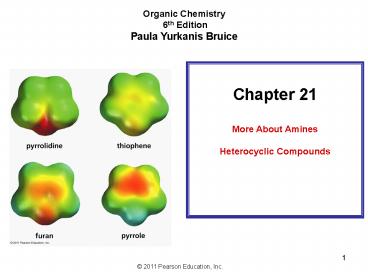21_Lecture.ppt - PowerPoint PPT Presentation
1 / 54
Title:
21_Lecture.ppt
Description:
The nitrogen withdraws electrons by resonance, resulting in an electron-deficient ring system. * Pyridine undergoes electrophilic aromatic substitution at C-3: ... – PowerPoint PPT presentation
Number of Views:123
Avg rating:3.0/5.0
Title: 21_Lecture.ppt
1
Organic Chemistry 6th Edition Paula Yurkanis
Bruice
Chapter 21 More About Amines Heterocyclic
Compounds
2
Nomenclature of Heterocycles
Cyclic amines (the names in quotes are preferred)
Nitrogen is 1 when numbering the ring
3
Heterocycles with oxygen and sulfur heteroatoms
(the names in quotes are preferred)
4
AcidBase Properties of Amines
Amines are the most common organic bases
5
Saturated amine heterocycles containing five or
more atoms have physical and chemical properties
typical of acyclic amines
6
Amines React as Bases and as Nucleophiles
The lone-pair electron on the nitrogen of an
amine causes it to be nucleophilic as well as
basic
7
Reactions of Amines
Nucleophilic substitution reactions
Nucleophilic acyl substitution reactions
8
Nucleophilic additionelimination reactions
9
Conjugate addition reactions
10
Reactions of Quaternary Ammonium Hydroxides
The Hofmann elimination is an E2 reaction
The leaving group of a quaternary ammonium ion
has about the same leaving tendency as a
protonated amino group
11
The hydrogen is removed from the b-carbon bonded
to the most hydrogens
The least-substituted alkene elimination product
is often called the Hofmann product
12
Quaternary ammonium ions, like alkyl fluorides,
are poor leaving groups
13
Hofmann elimination requires exhaustive
methylation of the amine, followed by elimination
A strong base, such as hydroxide ion, must be
used in the elimination reaction
14
Quaternary ammonium salts are used as phase
transfer catalysts in facilitating the reactions
between certain ionic and organic reactants
15
Consider the reaction between sodium cyanide and
an alkyl halide
16
Oxidation of Amines
Mechanism
17
Tertiary Amine Oxides Undergo a Cope Elimination
Reaction
The proton is removed from the b-carbon bonded to
the most hydrogens
18
Synthesis of Amines
Because ammonia and amines are good
nucleophiles, they readily undergo SN2 reactions
with RX
It is difficult to control the desired number of
alkyl substituents placed on the nitrogen
19
The Gabriel Synthesis of Primary Amines
20
Other Methods for Synthesizing Amines
21
Reduction of amides with LiAlH4
22
Aromatic Five-Membered Heterocycles
23
Pyrrole is an extremely weak base
24
The dipole moment in pyrrolidine (left) is
attributed to the electron-withdrawing property
of the nitrogen atom
25
(No Transcript)
26
Pyrrole, furan, and thiophene undergo
electrophilic substitution, preferentially at C-2
27
Electrophilic aromatic substitution reactions
28
Structures of the intermediates that can be
formed from the reaction of an electrophile with
pyrrole at C-2 and C-3
Three resonance structures more stable
Two resonance structures less stable
29
If both positions adjacent to the heteroatom are
occupied, electrophilic substitution occurs at
C-3
30
Why? Because of cation stabilization by lone-pair
resonance release
31
The relative reactivities of the five-membered
heterocycles in FriedelCrafts reaction
32
The resonance hybrid of pyrrole indicates that
there is a partial positive charge on the
nitrogen
Pyrrole is unstable in strongly acid solution
because the protonated pyrrole polymerizes
33
Pyrrole is more acidic than pyrrolidine because
of stabilization of its conjugated base by
resonance
34
(No Transcript)
35
Indole, benzofuran, and benzothiophene all
contain a five-membered aromatic ring fused to a
benzene ring
36
Aromatic Six-Membered-Ring Heterocycles
37
The pyridinium ion is a stronger acid than a
typical ammonium ion
Pyridine reacts like a tertiary amine
38
Pyridine Is Aromatic
- The nitrogen lone pair is not released into the
aromatic system because it is perpendicular to
the ? system. - The nitrogen withdraws electrons by resonance,
resulting in an electron-deficient ring system.
39
Pyridine undergoes electrophilic aromatic
substitution at C-3
40
(No Transcript)
41
The pyridine nitrogen is a meta director
42
Pyridine is reactive toward nucleophilic aromatic
substitution because of the presence of the
electronegative nitrogen
43
Pyridine undergoes nucleophilic aromatic
substitution at C-2 and C-4
44
If the leaving groups at C-2 and C-4 are
different, the incoming nucleophile will
preferentially substitute for the weaker base
45
Bromination and Oxidation of Substituted Pyridine
46
Diazotization of Aminopyridine
47
The a-hydrogens of alkyl substituents can be
removed by base to generate anionic nucleophiles
Pyridine a-hydrogen acidity is similar to that of
ketone a-hydrogens
48
Reactions of pyridine-based anionic nucleophiles
49
Quinoline and isoquinoline are ring-fused
pyridine derivatives
50
Some Biologically Important Heterocycles
Imidazole
51
(No Transcript)
52
(No Transcript)
53
Purine and Pyrimidine
54
Porphyrin































